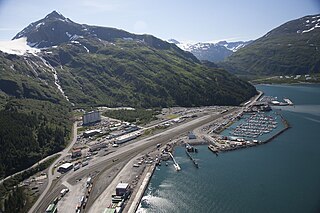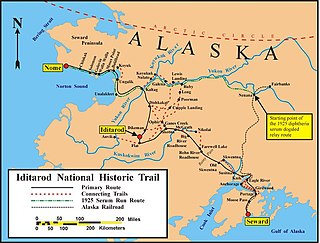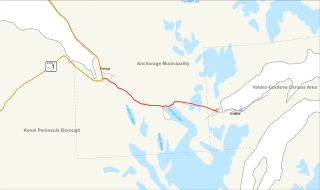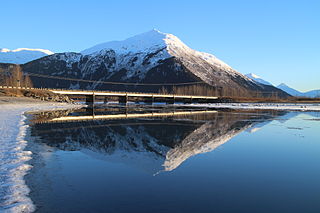
Seward is an incorporated home rule city in Alaska, United States. Located on Resurrection Bay, a fjord of the Gulf of Alaska on the Kenai Peninsula, Seward is situated on Alaska's southern coast, approximately 120 miles (190 km) by road from Alaska's largest city, Anchorage.

Whittier is a city at the head of the Passage Canal in the U.S. state of Alaska, about 58 miles (93 km) southeast of Anchorage. The city is within the Chugach Census Area, one of the two entities established in 2019 when the former Valdez–Cordova Census Area was dissolved. It is also a port for the Alaska Marine Highway. The population was 272 at the 2020 census, having increased from 220 in 2010. The city is notable for the fact that almost all of its residents live in the Begich Towers Condominium, earning it the nickname of a "town under one roof".

The 1964 Alaskan earthquake, also known as the Great Alaskan earthquake and Good Friday earthquake, occurred at 5:36 PM AKST on Good Friday, March 27. Across south-central Alaska, ground fissures, collapsing structures, and tsunamis resulting from the earthquake caused about 131 deaths.

Cook Inlet stretches 180 miles (290 km) from the Gulf of Alaska to Anchorage in south-central Alaska. Cook Inlet branches into the Knik Arm and Turnagain Arm at its northern end, almost surrounding Anchorage. On its southern end, it merges with Shelikof Strait, Stevenson Entrance, Kennedy Entrance and Chugach Passage.

The Alaska Railroad is a Class II railroad that operates freight and passenger trains in the state of Alaska. The railroad's mainline is over 470 miles (760 km) long and runs between Seward on the southern coast and Fairbanks, near the center of the state and the Arctic Circle, passing through Anchorage and Denali National Park where 17% of visitors arrive by train. The railroad has about 656 miles (1,056 km) of track, including sidings, rail yards and branch lines, including the branch to Whittier, where the railroad interchanges freight railcars with the contiguous United States via rail barges that sail between the Port of Whittier and Harbor Island in Seattle.

Girdwood is a resort town within the southern extent of the Municipality of Anchorage in the U.S. state of Alaska. Located near the end of the Turnagain Arm of Cook Inlet, Girdwood lies in a valley in the southwestern Chugach Mountains, surrounded by seven glaciers feeding into a number of creeks, which either converge within the valley or empty directly into the arm. Girdwood is typically accessed by the Seward Highway, with the main line of the Alaska Railroad paralleling the highway. By road distance, most of the community lies within 35 to 40 miles of Downtown Anchorage. The 2019 American Community Survey estimates a population of 1,742 in the valley.

The Seward Highway is a highway in the U.S. state of Alaska that extends 125 miles (201 km) from Seward to Anchorage. It was completed in 1951 and runs through the scenic Kenai Peninsula, Chugach National Forest, Turnagain Arm, and Kenai Mountains. The Seward Highway is numbered Alaska Route 9 (AK-9) for the first 37 miles (60 km) from Seward to the Sterling Highway and AK-1 for the remaining distance to Anchorage. At the junction with the Sterling Highway, AK-1 turns west towards Sterling and Homer. About eight miles (13 km) of the Seward Highway leading into Anchorage is built to freeway standards. In Anchorage, the Seward Highway terminates at an intersection with 5th Avenue, which AK-1 is routed to, and which then leads to the Glenn Highway freeway.

The Iditarod Trail, also known historically as the Seward-to-Nome Trail, is a thousand-plus mile (1,600 km) historic and contemporary trail system in the US state of Alaska. The trail began as a composite of trails established by Alaskan native peoples. Its route crossed several mountain ranges and valleys and passed through numerous historical settlements en route from Seward to Nome. The discovery of gold around Nome brought thousands of people over this route beginning in 1908. Roadhouses for people and dog barns sprang up every 20 or so miles. By 1918 World War I and the lack of 'gold fever' resulted in far less travel. The trail might have been forgotten except for the 1925 diphtheria outbreak in Nome. In one of the final great feats of dog sleds, twenty drivers and teams carried the life-saving serum 674 miles (1,085 km) in 127 hours. Today, the Iditarod Trail Sled Dog Race serves to commemorate the part the trail and its dog sleds played in the development of Alaska, and the route and a series of connecting trails have been designated Iditarod National Historic Trail.

Portage Glacier is a glacier on the Kenai Peninsula of the U.S. state of Alaska and is included within the Chugach National Forest. It is located south of Portage Lake and 6 km (4 mi) west of Whittier.

The Port of Alaska (POA) is a deep-water port located in Anchorage, Alaska with 3 bulk carrier berths, two petroleum berths, and one barge berth. It is an enterprise department of the Municipality of Anchorage. The name was changed from "Port of Anchorage" to the "Port of Alaska" in 2017. As such, the Port is distinguished from other types of municipal departments largely because it generates enough revenue to support its operations without being a burden to Anchorage property tax payers, and it also pays a fee-in-lieu of taxes to help run city government.
This article discusses transportation in the U.S. state of Alaska.

Anchorage is the largest city in the U.S. state of Alaska by population. With a population of 291,247 at the 2020 census, it contains nearly 40% of the state's population. The Anchorage metropolitan area, which includes Anchorage and the neighboring Matanuska-Susitna Borough, had a population of 398,328 in 2020, accounting for more than half the state's population. At 1,706 sq mi (4,420 km2) of land area, the city is the fourth-largest by area in the United States and larger than the smallest state, Rhode Island, which has 1,212 sq mi (3,140 km2).

The Denali Star is a passenger and semi-luxury train operated by the Alaska Railroad between the cities of Anchorage and Fairbanks Alaska. It is a seasonal train, only operating between the months of May and September. The Aurora Winter Train operates along the similar route during the rest of the year at a less frequent weekend schedule. The train is ridden by many tourists visiting the Denali National Park. The train consists of single level coaches and dome cars.

The Coastal Classic is a passenger and semi-luxury train operated by the Alaska Railroad between the cities of Anchorage and Seward, Alaska. It is a seasonal train, only operating between the months of May and September. Despite its seasonality, the Coastal Classic was the Alaska Railroad's most popular route in 2019.

The Hurricane, or Hurricane Turn, is a passenger train operated by the Alaska Railroad between Talkeetna and Hurricane Gulch in Alaska. This train is unique in that rather than making scheduled station stops, it is a flag stop train meaning that passengers between Talkeetna and Hurricane can wave a white cloth anywhere along the route and the train will stop to pick them up. The train runs daily Thursday through Sunday between the months of May and September and the first Thursday of every month the rest of the year. The Hurricane Turn is one of the last true flag-stop trains in the United States.

Portage is a ghost town and former settlement on Turnagain Arm in Alaska, about 47 miles (76 km) southeast of Downtown Anchorage. The town was destroyed in the 1964 Alaska earthquake when the ground in the area sank about six feet (1.8 m), putting most of the town below high tide level. All that remains today are the ruins of a few buildings and a "ghost forest" of trees that died after salt water inundated their root systems. Where there was once a town there is now only a railroad and road junction linking the Seward Highway and the Alaska Railroad to Portage Glacier park and the Anton Anderson Memorial Tunnel, which leads to Whittier.

The Portage Glacier Highway, or Portage Glacier Road, is a highway located in the U.S. state of Alaska. The highway is made up of a series of roads, bridges, and tunnels that connect the Portage Glacier area of the Chugach National Forest and the city of Whittier to the Seward Highway. Most of the highway travels through mainly rural areas just north of the Kenai Peninsula, with the Anton Anderson Memorial Tunnel passing under Maynard Mountain, part of the Chugach Mountain Range. Parts of the route were first constructed in the early 1900s, and the entire highway was completed on June 7, 2000, as part of the Whittier Access Project. The main portion of the highway traveling from the western terminus to the Begich, Boggs Visitor Center at Portage Lake is designated as National Forest Highway 35 by the United States Forest Service (USFS).

Indian is a community in the Municipality of Anchorage, Alaska, United States. It lies in a valley in the Chugach Mountains near the middle of the north shore of the Turnagain Arm of Cook Inlet. It is about 24 miles (39 km) southeast of downtown Anchorage and about 3 miles (4.8 km) northwest of Bird, and about 13 miles (21 km) west-northwest of Girdwood.

Girdwood Depot is a passenger railroad station in Girdwood, south of Anchorage, Alaska. The station offers service for the Alaska Railroad's Coastal Classic and Glacier Discovery routes.

Portage Peak is a 4,347-foot (1,325 m) elevation mountain summit located in the Chugach Mountains, in Anchorage Municipality in the U.S. state of Alaska. The peak is situated in Chugach National Forest, immediately east of Twentymile River valley, and 1.8 mi (3 km) west of Begich Peak. It is set midway between Girdwood and Whittier, with the Portage Glacier Highway and Alaska Railroad traversing the southern base of the mountain. Precipitation runoff from the peak drains into Turnagain Arm via Portage Creek and Twentymile River. This mountain is unofficially named in association with the creek and nearby Portage Lake, Portage Glacier, and Portage ghost town.





















